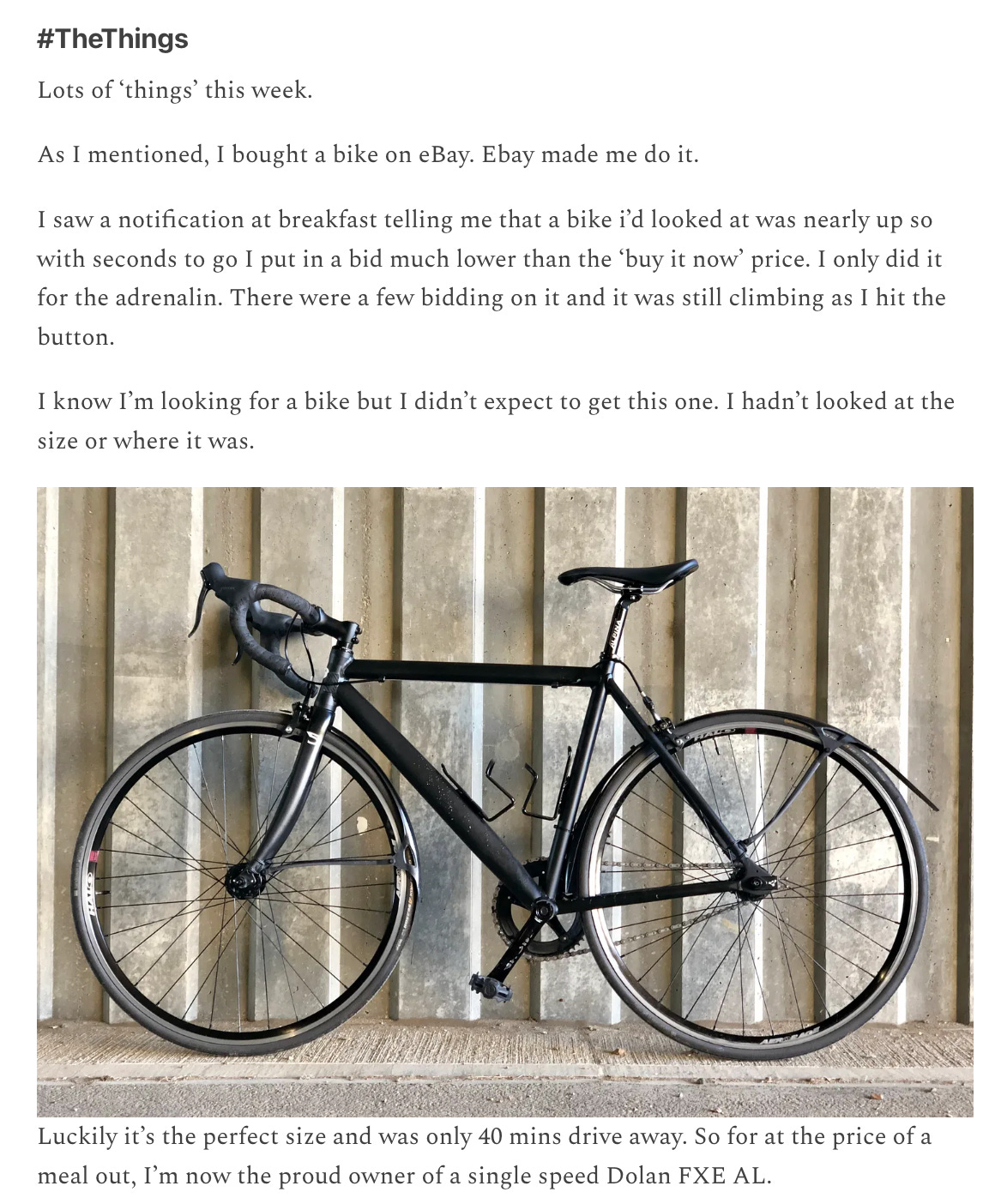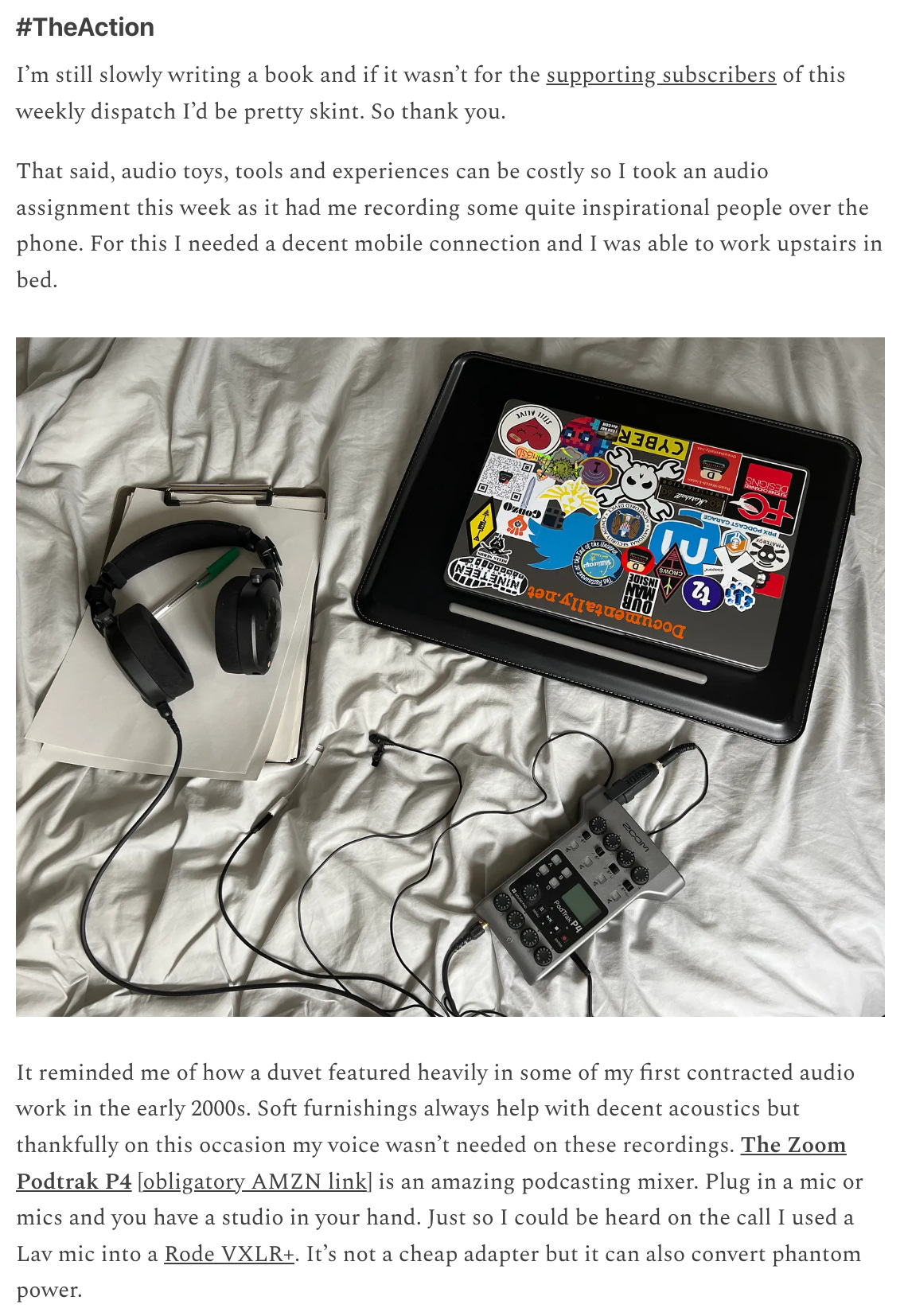Top 100 Paid Newsletters / Newsletter That's Pioneering A Unique Curation Approach
This is an experimental post format inspired by another Substack newsletter, Documentally by Christian Payne.
In his newsletter, Payne shares valuable and interesting curated images, audio, links, photos, and anything else related to what he’s exploring, but in a journal-like format.
Here’s part of a sample post:
Notice how he shares the recommended tool in the context of his life rather than just sharing an abstract recommendation? I like that.
I also like how he often connects one section to another as part of a larger narrative. For example, notice how the beginning of this section builds on a previous section…

What I love about this approach to curating is that it’s much more of a distinctive and interesting a way to curate than just to share:
3-5 links
That aren’t connected to each other
In a generic voice that anyone could’ve written
So, today I’m experimenting with this format. Then, at the very end, I provide a summary of all of the links along with my database of the top 100 paid newsletters that I spent 20 hours researching…
Today’s Game Plan
What Free Subscribers Get
The 10,000-Experiment Rule explains why I experiment so much. I share why I experiment with newsletter format and frequency.
Idea Connoisseurship is a must for thought leaders. It will drastically increase your odds of success. And, it’s how I came across Documentally.
Documentally is an example of format innovation. One under-appreciated way to stand out online is to have a unique post format.
What Paid Students Get
I spent 20+ hours researching the top paid newsletters in the world. I put my research into a Notion database. You can get this database at the bottom of this post as a paid subscriber.
How This Post Fits Into The Big Picture
Over the past few months, I’ve been sharing a lot about curation newsletters. I keep on returning to them because they’re the fastest and highest leverage way to get paid to learn. They are a great stepping stone to build research, a following, thought leader skills, and an income in order to create longer form content that gain traction.
Many experts who start writing online fail because they try to make too big of a leap like a beginning basketball player trying to dunk.
With that context given, let’s jump in…
The 10,000-Experiment Rule Explains Why I Experiment So Much
Our success at Amazon is a function of how many experiments we do per year, per month, per week, per day.
—Jeff Bezos
Today, I’m going a little meta so you can see inside my brain and copy what works.
The reason I found Documentally is because I’m a big believer in experimentation. More specifically, I have a mental model of experimentation that guides my decision-making.
Here’s how I apply it to this newsletter.
This newsletter is a combination of two things:
Within that overlapping section between the two circles is a lot of post formats I could try:
The results of those formats could be put into three categories…
Some formats might flop
Some format would be good
Other formats could could explode (in a good way)
Or shown visually…
One of my lessons learned from building the Mental Model Club to 2,000+ members is that it’s easy to continue a format just because it works even if it’s not the best. For example:
Even though the QWERTY keyboard isn’t as efficient as the DVORAK keyboard, it persisted because it became the standard.
The same thing happened with the MIDI audio format. Thanks to reader Christopher Landriau for sharing this story with me.
And the difference between something that’s good and something that’s great is night and day.
One of my regrets with the club is that I didn’t do more experimentation in the first months after it launched. I didn’t experiment, because it was “good enough” and because I didn’t want to shift subscriber expectations too much.
In retrospect, I should’ve explored the possibility space more. What I now know is that the club would’ve worked better as multiple posts per week delivered via email rather than one big manual per month stored in a learning management system. This format would’ve helped in three ways:
It would’ve made keeping up with the models easier, because each post was more bite-sized.
It would’ve encouraged more usage, because getting full posts in your email inbox reminds you to read and makes it easier to do so.
It would’ve grown the size of the club, because every post would’ve been sharable rather than being locked away behind a learning management system.
My guess is that this format would’ve taken the same amount of time to create and resulted in thousands of more subscribers.
EXPERIMENTATION RESOURCE
You can see an overview of my philosophy on experimentation in Forget The 10,000-Hour Rule; Edison, Bezos, & Zuckerberg Follow The 10,000-Experiment Rule.So the question becomes, how do you decide what experiments to do when you’re just getting started?
The Power Of Idea Connoisseurship
There is an impression abroad that literary folk are fast readers. Literary people read slowly because they sample the complex dimensions and flavors of words and phrases. They strive for totality not lineality. They are well aware that the words on the page have to be decanted with the utmost skill. Those who imagine they read only for "content" are illusioned.
―Marshall McLuhan
Any time I start something new in the thought leadership world and I’m still in the experimentation phase, I aim to become a connoisseur of it. I want to understand:
All of its variations (in all of its diversity)
What works and what doesn’t
What I like and what I don’t like
This way, rather than arduously re-creating experiments from scratch, I can build on top of what already works. Stated differently, millions of people have created newsletters before me. Tens of thousands have started paid newsletters. Most have failed. A few have succeeded. I want to understand what the ones that have succeeded have in common. Furthermore, it’s much easier to be creative by being inspired by someone else’s work and seeing a way to make it my own than it is to think from scratch—although, there is a time and place to think from scratch as well.
To be an Idea Connoisseur, you can:
Study the work of others
Interview others
A great example of general connoisseurship comes from Sam Altman, CEO and co-founder OpenAI (the company behind ChatGPT).
When making huge strategic decisions, he gets advice from a whopping 50 people!
Sam Altman Interview With Nicolai Tangen, CEO Norges Bank Investment Management
Here is a transcript of what Altman says:
My strategy is not to just have like one person that I go to with everything. And a lot of people do that. You know, they have like one mentor that they go to for every big decision. But my strategy is to talk to a ton of different people when I'm facing a big decision. And try to synthesize the input from all of that. So if I'm facing like a real major strategic challenge for OpenAI, you know, kind of one of these bet the company things.
I would bet that.
Counting people internal and external of the company, I'd talk to 50 people about it. And probably out of 30 of those conversations, I would hear something interesting or learn something that updates my thinking. And that's my strategy.
—Sam Altman
Wow! Imagine having 50 conversations with people to make one decision when you’re already an extremely busy person. Altman’s approach definitely has me reexamining how I identify and make the biggest decisions in my life.
In that spirit of connoisseurship, I’ve been studying the top paid newsletters in the world…
What I Learned Studying The World’s Top Paid Newsletters
The primary way that I’ve been finding top newsletters is via Substack’s leaderboards. You can click on one of the links below to see the top paid newsletters in that category:
Education | Culture | Politics | Finance | Music | Business | Food | Sports | Faith | News | Comics | Crypto | International | Climate & Environment | Science | Health & Wellness | Literature | Fiction | Parenting | Design | Travel | Philosophy | History | Humor | Fashion & Beauty
After finding the newsletters, I put the most successful (thousands of paid subscribers) and relevant (curated) newsletters into a database in Notion (Notion is the best digital note tool for thought leaders IMHO):
You can get a link to my database of top paid newsletters at the bottom of this post, if you’re a paid subscriber. So far I have put 20+ hours into it.
Beyond Substack, I also did some Googling. Through this, I found an amazing newsletter that reverse engineers how successful newsletters got their first 50,000 subscribers. It’s called Growth In Reverse, and it’s run by Chenell Basilio. Every week she spends 30+ hours deep-diving on the origin story of just one newsletter, and her writeups are extremely informative. For example, she did one fascinating writeup on a curation newsletter (TLDR) that earns millions of dollars per year, and it only takes the founder 30 minutes to put together each day.
I particularly wanted to understand curation newsletters like The Browser, which I recently featured. Curated newsletters are amazing because for just a little bit of time and writing skill, you can create a newsletter with hundreds of thousands of free subscribers and hundreds of thousands in revenue. These types of newsletters may be the closest you can get to getting paid without heavy-duty writing.
Finally, I also emailed Linda @ Substack, who I met via Michael Thompson of memorable, to ask if she recommended any Substack curation newsletters. That’s when she recommended Documentally among other curated newsletters like 5 Things You Should Buy.
Documentally Is An Example Of Format Innovation
In the competition for people’s limited attention, the worst thing you can be is just like everyone else. Being like everyone else is functionally equivalent to being invisible.
There are many parts of the thought leadership process you can stand out in…
Niche
Research
Ideas (ones you name and become known for)
Production quality (ie - writing / editing)
Platform
Marketing
Etc.
One of the underestimated ways of standing out is to have a unique and valuable content format. I call this format innovation.
For example, Jack Butcher found an amazing way to combine quotes and original visuals into an incredibly popular Twitter account:
Tim Urban of WaitButWhy pioneered a format of super long articles, on fascinating topics, written in a cheeky way, with lots of hand-drawn visuals.
Documentally (created by Christian Payne) combines the power of journaling, the power of curation, and the power of mixed media:
Curation. When I read his stuff, I discover new tools, sites, documentaries, etc.
Journal. Many curation newsletters are popping up that share a list of resources in a bullet list. What I like about the journal format is that these resources can be interleaved with each other into a larger narrative. Journals are much more personal, and I personally love expressing myself in the voice of a journal. So much so that I have journaled for an hour a day for 20+ years.
Mixed Media. He often shares photos he’s taken over the years, voice notes he records, and embeds videos he finds interesting.
Takeaway: What Do You Think About Documentally’s Format?
I’m very curious about your thoughts on the multi-media, journal-based, curation newsletter format.
Would you enjoy seeing a post like this once a week from me?
Could you see using this format in your own posts?
Summary Of Today’s Links
Newsletters
Documentally (unique approach to curation)
Growth In Reverse (breaks down how top newsletters got their first 50k subscribers)
The Browser (curates and summarizes 3-5 top articles daily)
5 Things You Should Buy (curates 5 fashion outfits you should buy weekly)
TLDR (7-figure tech curation newsletter that’s sent out daily)
Article
Forget The 10,000-Hour Rule; Edison, Bezos, & Zuckerberg Follow The 10,000-Experiment Rule (article I wrote)
Tools
Notion (for note-taking)
Mental Models
10,000-Experiment Rule
Idea Connoisseurship
Format Innovation
Top 100 Paid Newsletter Database
(For Paid Subscribers)
The newsletter has the following columns, which can be sorted:
Name
URL
Type
# Paid Subscribers
# Free Subscribers
Category
Creator
Monthly Fee
Posts Per Month
Description
My comments
This database is live, which means that I’ll be updating it as I do more research.









